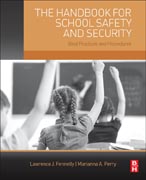
The Handbook for School Safety and Security: Best Practices and Procedures
Fennelly, Lawrence
Perry, Marianna
School security is one of the most pressing public concerns today. Yet in most schools, there is little security expertise or detailed knowledge about how to implement and manage a security program. The Handbook for School Safety and Security rectifies this problem by providing the salient information school administrators and security professionals need to address the most important security issues schools face. Made up of contributions from leading experts in school security, The Handbook for School Safety and Security provides a wealth of practical information for securing any K-12 school. It discusses key approaches and best practices for school crime prevention, including such topics as crisis management and mass notification. It also covers the physical measure needed for protecting a school, including detailed discussions of access control, lighting, alarms, and locks. While there is no single fix for the myriad of security challenges facing today's school security professionals, the best practices found in The Handbook for School Safety and Security will help increase the safety and security of any school. Brings together the collective experience of industry-leading subject matter specialists into one resource.Covers all the key areas needed for developing and implementing a school security program.Includes a list of 100 things to know when developing a school security program. INDICE: PART 1: APPROACHES AND BEST PRACTICES FOR SCHOOL CRIME PREVENTION Chapter 1: Best Practices: A Sixteen-Point Master Plan Chapter 2: Threats and Hazards at Educational Institutions Chapter 3: Risk Assessment and Prevention for K-12 Schools Chapter 4: CPTED Applications for Schools Chapter 5: An Overview of School Safety and Security Chapter 6: Empowerment of Crisis Management in Emergencies Chapter 7: Prevention and Safety Issues Chapter 8: Think Prevention and Think Safety Chapter 9: Understanding How to Use the Process Hazard Analysis (PHA) and the Layers of Protection Analysis for K-12 Schools Chapter 10: Mass Notification Requirements for Our Children's Schools Chapter 11: You Get What You Pay For (Or, When Free is Not Really Free) Chapter 12: An Access Control Template for K-12 Schools Chapter 13: Crime Risk versus Feeling Safe in Schools: True and False Risk Assessment in Schools Chapter 14: Partnering with Local First Responders and Public Safety Officials Chapter 15: Emergency Management Procedures Chapter 16: Policies and Procedures for Schools PART 2: APPROACHES TO PHYSICAL SECURITY Chapter 17: An Overview of Physical Security Technology for Schools Chapter 18: Hardware Function Choices and Lockdown Procedures Chapter 19: Security Lighting for Schools Chapter 20: Intrusion Detection Systems for Schools Chapter 21: Video Technology Overview Chapter 22: Access Control, Access Badges, and Biometrics Characteristics Chapter 23: Fire Alarm Systems for Schools PART 3: APPROACHES TO OPERATIONAL ISSUES AND SPECIFIC THREATS AND SOLUTIONS Chapter 24: A Look at School Security in Australia Chapter 25: Prevention of Crime in and around High Schools Chapter 26: Operational Issues, Threats, and Solutions Chapter 27: 100 Things You Need to Know about School Security Appendix: ASIS International's List of School Security Websites, Associations and Organizations, and Publications
- ISBN: 978-0-12-800568-2
- Editorial: Butterworth-Heinemann
- Encuadernacion: Rústica
- Páginas: 416
- Fecha Publicación: 22/08/2014
- Nº Volúmenes: 1
- Idioma: Inglés
